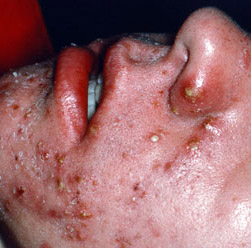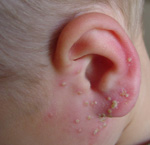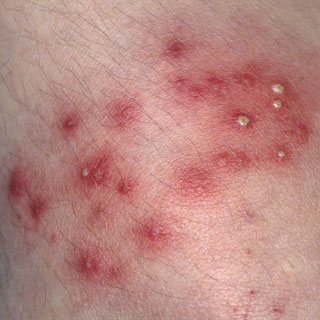Types of Folliculitis And Folliculitis Treatment
You have seen the bumps on a man’s neck and felt bad that he could not afford a new razor. Maybe you have experienced those bumps yourself? You may have wondered why acne would appear on your neck from shaving. The truth is, it’s not acne and it is not only caused by bacteria but can also result from fungus, virus or parasites.
It is not Acne; it is called Folliculitis, which is the inflammation of one or more hair follicles occurring anywhere on the skin. The common symptoms are a rash, itching and pimples or pustules near a hair follicle on the neck, groin or genital area.
Some day to day things to change to reduce the incidence of Folliculitis is to reduce friction from clothing, avoid shaving or use a new, clean razor each time you shave. You may want to sterilize the razor. Lastly do your best to keep the area clean and avoid clothing and washcloths that could be contaminated.
As has been mentioned there are four different types of Folliculitis, they are:
Bacterial Folliculitis
 Bacterial Folliculitis is a result of one of the types of the Staphylococcus bacteria, Pseudonomas, Proteus or Coliform bacteria getting under the skin by some break in the skin and infecting a hair follicle. Once the bacteria are trapped under the skin it is possible for it to spread to other parts of the body.
Bacterial Folliculitis is a result of one of the types of the Staphylococcus bacteria, Pseudonomas, Proteus or Coliform bacteria getting under the skin by some break in the skin and infecting a hair follicle. Once the bacteria are trapped under the skin it is possible for it to spread to other parts of the body.
The types of Folliculitis caused by bacteria are “Hot Tub” Folliculitis and Gram-Negative Folliculitis. Superficial Folliculitis, also known as Impetigo, consists of pustules but the infection can go deeper into the skin causing pain and pus. These can often result in scarring to the skin.
Superficial Folliculitis often responds to a topical antibiotic like Mupirocin or Fusidic Acid Ointment. In cases where the Folliculitis has gone deeper into the skin require broad-spectrum antibiotics like cephalosporins, macrolides, or fluoroquinolone. If the furuncles or carbuncles do not rupture and drain on their own they may require to be lanced.
 Fungal Folliculitis
Fungal Folliculitis
 Fungal infections are either superficial or deep and can even spread to the blood or internal organs. There are three groups of fungal infection in the body; Dermatophytic Folliculitis, Pityrosporum Folliculitis and Candida Folliculitis.
Fungal infections are either superficial or deep and can even spread to the blood or internal organs. There are three groups of fungal infection in the body; Dermatophytic Folliculitis, Pityrosporum Folliculitis and Candida Folliculitis.
Dermatophytic Folliculitis is caused by a fungal species and the severity of the infection will be directly related to the depth of fungal penetration in the hair shaft. Ringworm is a well-known example of this condition. Large pustules filled with pus is typical as well as loss of the hair shaft. Often there is scarring and some types of deep penetration can even cause pain, fever, scarring and permanent hair loss. Treatment options that are shown to be effective include Griseofulvin and Terbinafine Hydrochloride (Generic Lamasil).
Pityrosporum Folliculitis is caused by a yeast in which the yeast gets into the hair follicle and colonizes resulting in an itchy eruption. This condition can be treated effectively with a topical antifungal agent.
Candida Folliculitis is caused by the candida fungus and is the most common in infecting people. This is best treated with Itraconazole, a broad-spectrum antifungal agent.
Viral Folliculitis
 This is an infrequent infection of the hair follicle by a virus such as the herpes simple virus or herpes zoster virus. They are treated by the use of oral antihistamines or surgical removal.
This is an infrequent infection of the hair follicle by a virus such as the herpes simple virus or herpes zoster virus. They are treated by the use of oral antihistamines or surgical removal.
Parasitic Folliculitis
 Parasites cause Folliculitis when they burrow their way into a hair follicle to live there or lay eggs. Two mites, Demodex Folliculorum and Demodex Brevis are natural hosts of the hair follicle. A commonly known form of this infection is Rosacea. Treatment options include a topical Permethrin Cream, Systemic Ivermectin or Itraconazole.
Parasites cause Folliculitis when they burrow their way into a hair follicle to live there or lay eggs. Two mites, Demodex Folliculorum and Demodex Brevis are natural hosts of the hair follicle. A commonly known form of this infection is Rosacea. Treatment options include a topical Permethrin Cream, Systemic Ivermectin or Itraconazole.
In conclusion this can be a physically and emotionally painful experience. A medical professional should be consulted with to determine the cause of the inflammation so proper treatment can be started.














Comments on Types of Folliculitis And Folliculitis Treatment
Thank you for the information on this page. It definitely helps me understand folliculitis more.
I seldom leave comments on blog, but I have been to this post which was recommended by my friend, lots of valuable details, thanks again.
I did not know there were different types of folliculitis.
It has changed my perspective.
Pat
This was very helpful.
Really glad this article helps.
Sarah
RBS Representative